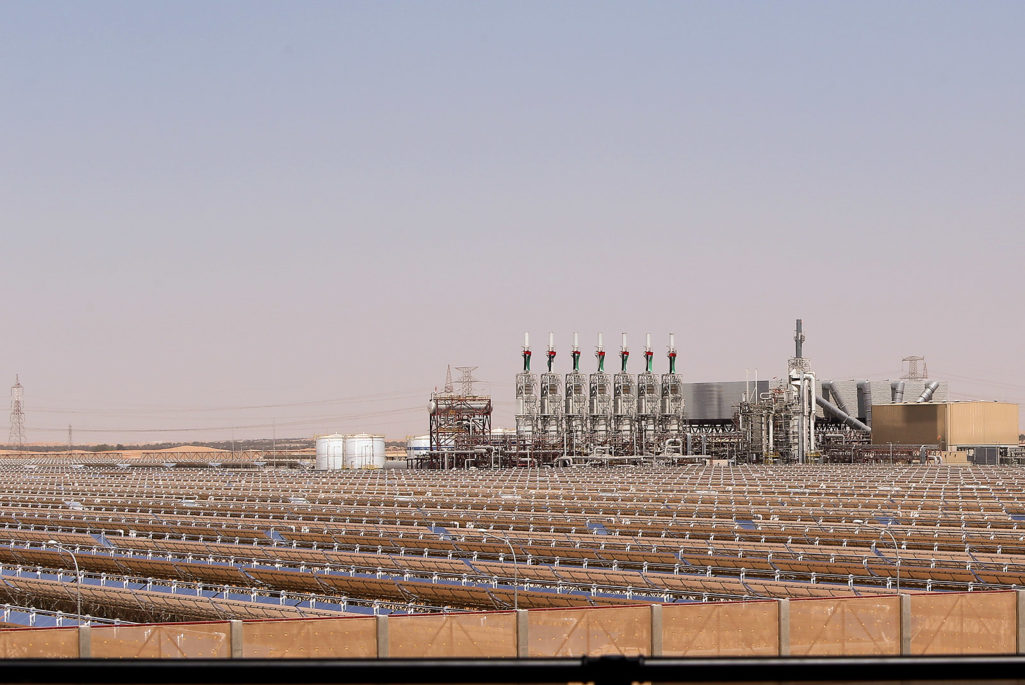UAE—A Case Study in Managing the Energy Trilemma

A balcony in Abu Dhabi overlooks Shams-1, one of the world’s largest Concentrated Solar power plants. It provides electricity to 20,000 homes.
Photo: Marwan Naaman/AFP/Getty Images
How to manage the Energy Trilemma—the balance between secure, affordable, and environmentally sustainable energy—is a critical question facing all countries, regardless of their energy resources.
There is no single right solution to this trilemma and each country develops and adapts its approach and policies taking into account energy resources and needs, economic goals, social needs, and opportunities stemming from new technologies.
The United Arab Emirates offers a case study in the evolution of approaches to balancing the energy trilemma. From an initial focus on using its abundant oil reserves, the UAE has widened its view on energy security to include a diversity of energy sources—including nuclear and renewables—as well as energy efficiency and demand side management. This energy security approach provides affordable energy to fuel a diverse economy and improve overall environmental sustainability. Public acceptance of the country’s plans for demand-side efficiencies may also require a re-examination of its subsidy system.
Today, planning for energy security and sustainability is on the top of our government’s agenda. Energy will continue to be an economic cornerstone of the UAE and will strengthen the country’s competitiveness in the future.
Early Focus on Leveraging Available Energy Resources
Since the early days of our union, the government used local oil resources to build a reliable energy infrastructure to guarantee the availability of electricity and fuel to its entire population. As our population and economy grew, the government realized the need to reduce the use of liquid fuel and replace it with natural gas for environmental and cost factors. That’s also when we decided to diversify the natural gas fuel sources and consider importation.
In 2007, Dolphin Energy, a gas company established by the government in 1999, began importing 2 billion cubic feet per day of compressed natural gas via a subsea pipeline from Qatar, which we also supplied to Oman. Today, natural gas from Dolphin Energy supplies almost half of our electricity requirements and allows us to remain almost 100 percent dependent on natural gas for power generation.
In addition to imports, we have also started developing some of the most challenging unconventional sour gas reservoirs in Abu Dhabi. The gas development is part of a broader production capacity enhancement project aiming to set the country at 3.5 million barrels of oil per day by 2017. The production capacity enhancement will ensure the country’s position as a long-term oil supplier to the world and keep up with growing local demand. We also upgraded our refinery output to more than 1 million bopd by the end of 2015 from the previous level of 500,000 bopd.
A Growing Focus on Diversity of Energy Supply
With rapid economic growth and the rise of oil prices, the UAE government again realized the need to cultivate diverse energy sources—that’s when we decided to introduce nuclear power and started a journey with the international community to get the endorsement of a state of the art peaceful, safe and secure nuclear program. The Emirates Nuclear Energy Cooperation is constructing four nuclear plants, which will provide 5600 MW-H of emission-free electricity. This will help the UAE reach its clean energy target of 24 percent by 2020.
The UAE believes that sustainable energy will play a key role in complementing conventional sources.
In the UAE we believe in the future energy evolution and expect that sustainable energy will play a key role in complementing conventional sources. Our capital, Abu Dhabi, will be an international hub for renewable energy, new energy, and sustainable technologies, thereby balancing its already strong oil-producing position. As an expression of this strategy, Abu Dhabi hosts the headquarters of the International Renewable Energy Agency. As part of its commitment to sustainability, and in order to encourage the development of a knowledge-based, export-oriented renewable energy sector, the Abu Dhabi government has made a commitment to renewable power. This decision supports the ongoing diversification of the country’s economy and is expected to create a domestic renewable energy market.
Sustainable energy is becoming part of our future energy mix, and we are expecting it to contribute at least 5 percent of the energy mix in the near future. Currently, we have three solar projects feeding the grid, and one of them is Shams-1: One of the world’s largest concentrated solar power plants with a capacity of 100 MW-H. The plant is expected to displace 175,000 tons of CO2 every year, equivalent to planting 1.5 million trees or taking approximately 15,000 cars off the road.
Managing Energy Use to Increase Security and Sustainability
The Ministry of Energy is mandated to structure the National Energy Conservation Law as part of the UAE’s energy policy. With multiple initiatives for improving the energy efficiency of buildings, we have a good base to start from. Changing consumption behavior will require some time, and speeding up public acceptance of this plan may require us to reexamine our subsidy system in the UAE.
With the wisdom of our leadership and good planning, we can be an example in the region by building a balanced and sustainable energy policy that ensures security and availability, affordability, and sustainability of resources.




